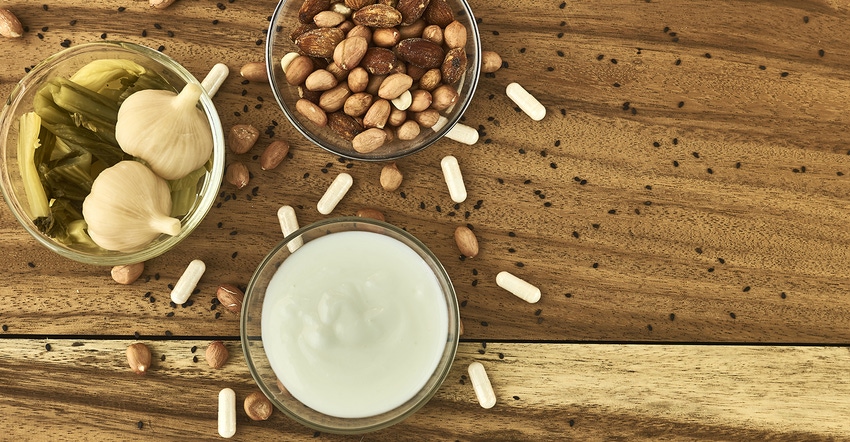Navigating 'biotics': Challenges and trends in probiotic and prebiotic formulations
With consumers starting to catch on to prebiotic fibers and the processing advantages over probiotics, is it time to ditch the friendly bacteria for their lunchbox?

At a Glance
- Probiotics can pose challenges for formulators.
- Prebiotics avoid shelf-life stability and GI tract survival issues.
- A lot of consumer education is still required.
[Editor's note: Download the Natural Products Insider digital magazine here on biotics for formulating tips and tricks, marketing insights and business strategies to capitalize on the huge market for supplements powered by probiotics and prebiotics.]
With an abundance of research recently focusing on the microbiome’s connection to several aspects of health and consumers showing an increased interest in pre-, pro-, and postbiotics, brand managers worldwide are tasking their R&D staffs with developing new products based on biotics. However, formulators face a formidable challenge in navigating the complexities of these ingredients to create effective and tailored products that truly benefit consumers.
Biotics are becoming increasingly popular worldwide, which can be seen in the growth of the market and in the increased number of new product launches. The global probiotics market is estimated to grow at a CAGR of 8.54% during 2021-26 and balloon to nearly $31 billion in 2026, accounting for supplements, foods, beverages and animal feed.
Probiotic and prebiotic products mostly populate high-volume and high-growth segments: digestive health and immunity. For example, in 2023, True Grace launched an extension of their women’s health line with a product based on probiotics and vitamin D3 and positioned it for digestive health and immunity. In 2022, Jarrow Formulas launched an immunity product based on a combination of probiotic strains, zinc, and vitamins C and D. Xtend-Life based their 2023 digestive health product on Livaux, a patented precision prebiotic.
Additionally, consumer awareness for such products is growing. In a 2022 survey, performed by International Food Information Council, 58% of consumers stated they are familiar with probiotics (of which 32% actively try to consume them), with similar results for prebiotics and 35% familiar with postbiotics, of which 13% try to actively consume them.
Among biotics, probiotics are the most used and researched. According to FMCG Gurus, 62% of global consumers have used probiotic food or drink products in the last 12 months. This number has been steadily increasing in recent years, as consumers become more aware of the potential health benefits of probiotics. The same research also found that probiotic use is highest in Asia Pacific, where 73% of consumers have used probiotic products in the last year. This is followed by Latin America (68%), North America (63%), and Europe (59%).
Probiotic problems
However, probiotics can pose several challenges for formulators and manufacturers, such as instability, overage, the need for a dedicated production line and higher production costs.
Firstly, there is an issue with stability due to probiotics being living microorganisms. The challenge entails not only ensuring that these microorganisms survive the production process but also the entire shelf-life period that follows. The production process alone can be too demanding for them in terms of pressure and temperature, but then there are also conditions inside the product that can cause many of these microorganisms to die. The third and final environmental challenge in the product’s journey is digestive tract survival. Stomach acid and other digestive conditions inflict perhaps the harshest test on the active ingredient at the very end. If they don’t reach their final destination alive, they fail to deliver the efficacy meticulously planned in the formulating process.
To achieve a sufficient number of living microorganisms in the product at the end of the shelf life, many manufacturers resort to adding a so-called overage to the product — a raw material surplus. Adding overage is not unique to probiotics; this is also quite common with several unstable vitamins, for example. The main difference with adding overage with probiotics and other ingredients is in the amount of material added. While with other ingredients the overage is somewhere between 10% and 20%, with probiotics up to 10 times the amount declared on the label (or sometimes even more) of raw material surplus can be added. This causes a significant variation of the product at different points of its shelf life and consumers effectively end up receiving a completely different version of the product depending on when they buy it. Consequently, the product can have a different effect and sometimes the overage (in large amounts) can even cause unwanted side effects for consumers.
Because probiotics are living entities, there is also a need for a dedicated production line. These microorganisms are extremely small and can sometimes exist in the form of spores (a form in which microorganisms transform to survive unfavorable conditions and, as a result, become highly resistant to environmental factors). If manufacturers don’t have a separate production line with sufficient cleaning, remnants of microbial cultures can appear in products that are later developed on the same production line.
In this case, two risks exist — during post-production testing, microbiology values will be too high (contamination will be detected), and the product cannot be released for sale or contamination could occur even after the product is already on the market (products contain sugars, water, etc., making them an excellent breeding ground for microorganisms), which can lead to recalls. Generally, preservatives in liquid products are used to try to prevent such occurrences. However, the risk is much smaller if probiotics are produced on a dedicated production line.
Linked to the previous point, the cleaning process after probiotic production must be extremely thorough and the protocols are very complex. Considering the high temperatures, a variety of detergents, and the time involved, this also results in a significant additional expense. Similarly, such production must be well-isolated to prevent cross-contamination with other production lines during the preparation and manufacturing processes. Most probiotics need to be stored in a freezer before production, which also means more expensive transportation and storage. Additionally, to maintain the product’s stability, costly protective materials need to be used during packaging (e.g. blisters, no plastic) which ensures that outside effects like humidity are minimized.
Prebiotic solutions — and problems
Many of these manufacturing problems can be bypassed if formulating with prebiotics instead. The difference between the two biotics is that probiotics are living microorganisms, while prebiotics are a substrate that is selectively utilized by host microorganisms conferring a health benefit.
Since prebiotics are inanimate substances, they avoid shelf-life stability and digestive tract survival issues. Because they promote the growth of native microflora, as opposed to introducing new microorganisms to our system, prebiotics are sometimes also promoted as the safer option. It comes as no surprise that prebiotics have quickly evolved from commodity-based, high-volume ingredients for functional foods to a booming premium supplement segment based on clinically supported branded ingredients and are now being launched by some of the world’s leading and most innovative brands.
For example, ActivatedYou, a brand of wellness supplements by actress Maggie Q, added a prebiotic line in 2023 and positioned it for boosting metabolism and managing weight. Pharmaceutical and practitioner channel brands such as Bayer, Sanofi, Life Extension, Boots, NOW Foods, GNC, P&G, Country Life, Culturelle, Microbiome Labs and Holland & Barrett have also all launched prebiotics with a branded and studied main ingredient in recent years.
However, prebiotics come with their own set of challenges. For formulators, the main ones are clumping and gelling.
Clumping occurs when prebiotic fibers absorb moisture from the air and form clumps. This can make it difficult to mix prebiotics into food and drinks, and it can also reduce their shelf life. Gelling occurs when prebiotic fibers dissolve in water and form a gel. This can make prebiotic supplements difficult to swallow and can also alter their taste and texture. These issues are usually caused by high moisture, the presence of other ingredients in the formulation, the pH of the formulation and the type of prebiotic fiber being used. Controlling the moisture content and the pH of the formulation and choosing fibers less prone to clumping and gelling can help solve the issues. In addition, supplement manufacturers can also use a variety of excipients to improve the flowability and dispersibility of the prebiotic product.
From a marketer’s perspective, there is also the issue of lower consumer awareness and the need for education from brands launching prebiotic products. In November 2022, FMCG Gurus performed a survey in which, across all age cohorts, approximately half of consumers had heard of the word "prebiotics" (for instance, 48% of Generation Z answered that they had heard of this). However, a lot of education on the effect of the ingredient is still required. Only 8% of Generation Z consumers included in the survey stated that they understand the difference between prebiotics and probiotics and their key role in one’s health.
Recently, brands are also increasingly launching synbiotics, which are a combination of different types of biotics, such as prebiotics and probiotics. For example, in 2022, Ritual launched a Synbiotic+ product based on branded prebiotics, probiotics and postbiotics. In 2023, Goli Nutrition launched the world’s first pre+post+probiotic gummies positioned for digestive health, immune support and a balanced gut. A British brand aguulp for biome, co-launched by British rapper Professor Green, also launched a synbiotic product in 2023.
The main issue with such products is that the area is not well researched yet, and we have very little information on the specific interaction between prebiotics and probiotics — in the products as well as in the human body. Too many conclusions on the effect of the product are still drawn from general data on individual probiotic strains. When we talk about the composition of the gut and its impact on the microbiota, which already varies greatly from person to person, it's difficult to expect universal answers.
In the rapidly growing biotics market, formulators face many challenges. When looking at probiotics, product development requires a dedicated production line, there is an issue of stability and overage, and production costs for such products can get quite high.
Prebiotics may be a better option for formulators, but they also come with their own set of challenges, such as clumping and gelling. Although consumer awareness of the potential health benefits of such products is growing, a lot of education is still required. This can make probiotics momentarily more appealing to brands deciding to launch a new product, but we can expect the future to level the playing field and favor the ingredients that are backed with the most research and the best user experience.
Download the Natural Products Insider digital magazine here on biotics for formulating tips and tricks, marketing insights and business strategies to capitalize on the huge market for supplements powered by probiotics and prebiotics.
About the Author(s)
You May Also Like






.png?width=800&auto=webp&quality=80&disable=upscale)